Haswell Z87 Motherboard Preview: 50+ Motherboards from ASUS, Gigabyte, ASRock, MSI, ECS, Biostar and EVGA
by Ian Cutress on May 22, 2013 5:00 PM ESTMSI Z87
MSI have kept their cards relatively close to their chest on this one, except for one microsite detailing the core of their gaming and overclocking range. So far we have details on:
MSI Z87-GD65 Gaming
MSI Z87 MPower
MSI Z87 MPower Max
MSI Z87 XPower
It seems that the Big Bang moniker is finally gone, with MPower being the mid-range overclocking motherboard and the XPower being used for those sub-zero extremists.
MSI Z87A-GD65 Gaming
It was not too long ago that we had a look at the Z77A-GD65 Gaming, whereby MSI described to us that the Gaming range was initially intended for Haswell launch, but due to the extra delay added on by Intel they decided to forge ahead with a Z77 model. Back with that model, there was various limitations on what they could do (either physical or temporal), but Z87 has brought some of them out. Looking at the board we see larger heatsinks for the VRM and the Dragon, as well as Audio Boost:
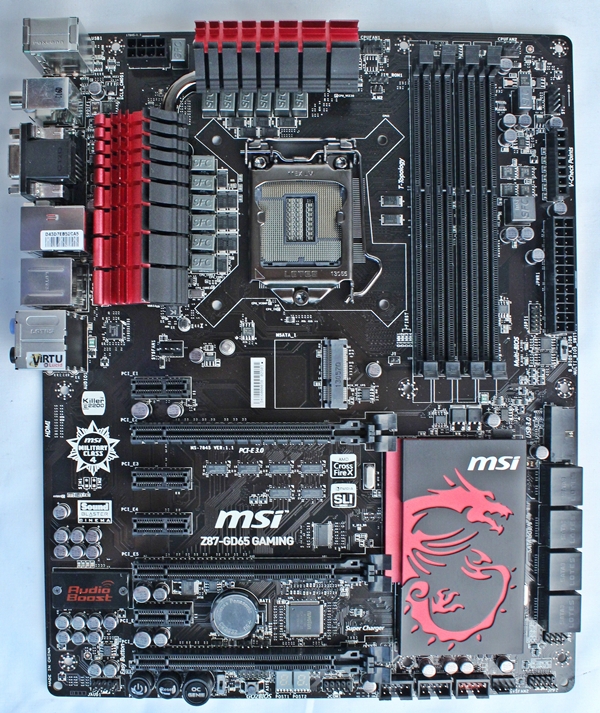
I was initially fooled by the lines on the board with the mSATA, thinking it was something special, but the fastener for the screw means that it is only an mSATA port. The big thing on the left hand side of the board is obviously Audio Boost, which given the motherboards already seen in this preview I would hazard a guess at an ALC1150 hiding under an EMI shield. The microsite states support for 600 ohm headphones as well.
On the board itself we see MSI voltage checkpoints, eight SATA 6 Gbps (it seems all are coming from the chipset?!), the classic OC Genie, also Go2BIOS for Windows 8 users/overclockers. Multi-BIOS also makes an appearance, selectable by a BIOS switch.
MSI Z87 MPower / MPower Max
Source: 59hardware, PC Authority
MSI seems to be splitting their overclocking motherboards into two groups – MPower for the lower cost 24/7 overclocking, and XPower for extreme overclock users. For the MPower, two versions are being released – a normal version and a MAX version. These two boards look very similar, and without close inspection we might miss the differences between them.
The MPower Max:
The MPower:
The differences I can fathom are a slightly rearranged audio layout, moving the two-digit debug from the corner to below the 24-pin ATX connector, the fan headers being slightly rearranged and the OC Genie button moved. Nevertheless on both boards we get Audio Boost, voltage check points, eight SATA ports, what looks like an x8/x4/x4 PCIe layout, an mSATA in the idle of the board, a ClearCMOS button at the back and what looks like space for an extra card on the rear IO. In fact some of the images on the MSI Microsite suggest that this is an 802.11n card – this means the Max might have the card and the normal MPower may not as a price point differentiator.
MSI Z87 XPower
MSI have kept the Z87 XPower very close to their chest. The only images we have are mild corner or socket focused images, but nonetheless it offers potential. At least we can see a big yellow X on there:
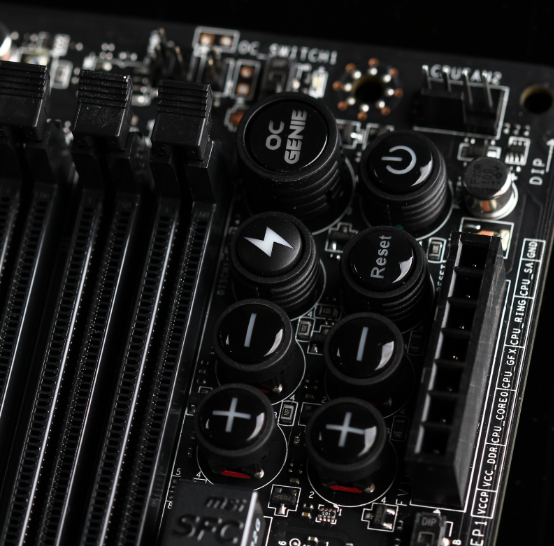
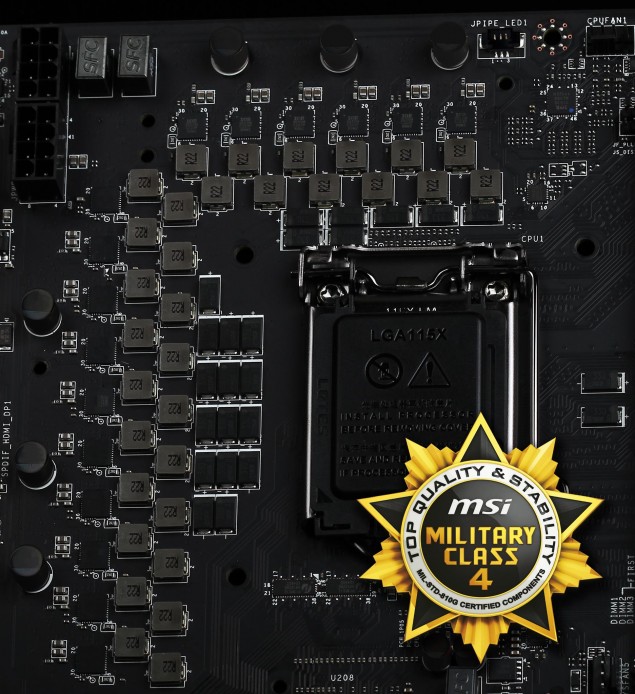
Source: WCCFTech
Biostar Z87
Source: GamersNexus, Hardware.info
During our time on Z87, Biostar never really jumped into the picture. There were murmurings of their Puro audio solution, using pairs of large caps to help filter out analog signals. When it comes to the new Haswell generation, we got wind of several boards coming to market:
Biostar Hi-Fi B85S3 (mATX)
Biostar Hi-Fi H87S3+ (mATX)
Biostar Hi-Fi Z87W
Biostar Hi-Fi Z87X 3D
Gone are the years of orange Biostar boards – whereas everyone seems to be moving away from blue, Biostar are bringing it back with their higher end range.
Biostar Hi-Fi B85S3
First up is a B85 board in a micro-ATX form factor:
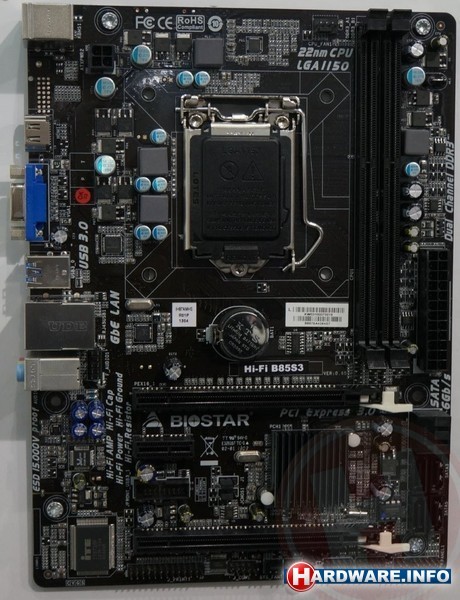
While Biostar are keen to announce the use of USB 3.0, the LGA1150 socket, PCIe 3.0, SATA ports and DDR3, the text relating the audio interests me more. Here we have ‘Hi-Fi AMP’, ‘Hi-Fi Cap’, ‘Hi-Fi Power’, ‘Hi-Fi Ground’ and ‘Hi-Fi Receiver’, which could mean we have a half decent audio solution on a cheap end board, but I would not hold my breath – judging by the three audio outputs we probably have an ALC889 onboard.
The PCIe layout suggests an x16/x1/x1/x4 layout due to the B85 chipset, and the SATA ports have two upright and four coming out of the board. The Rear IO looks a little bare but we clearly have a HDMI, VGA, and a few USB 3.0 ports.
Biostar Hi-Fi H87S3+
Moving up the chain to H87 we have a similar looking board to examine, especially in terms of IO.
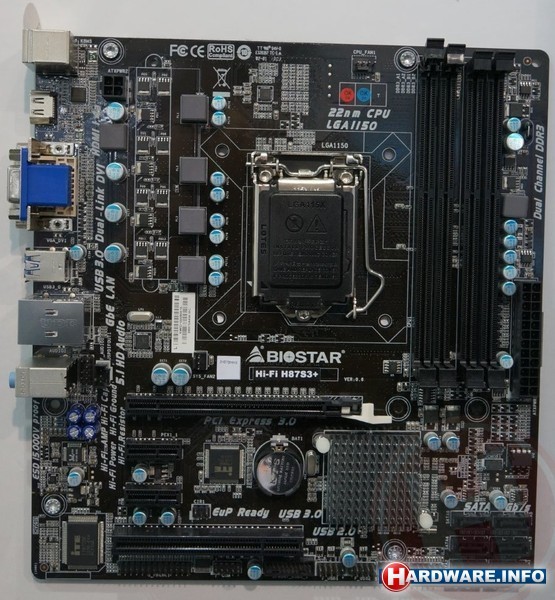
The PCIe lane allocation is sporting a PCI connector at the bottom, and the SATA ports (there seems to be six under the logo) are all coming out of the board. The audio solution still looks like an ALC889 however. On the IO the VGA looks like it is now above a DVI connector.
Biostar Hi-Fi Z87W
The full ATX models from Biostar are starting to actually look nice, rather than the orange of yesteryear. The Z87W comes in focused all within the Puro Hi-Fi:

So Puro was on Z77 but unfortunately we did not have a deep look at it. With Z87 I do hope they are using the ALC1150 as well as supporting 600 ohm headphones, though without technical specifications I can only speculate. Biostar have never been one for multi-GPU setups, but we get what looks like an x8/x8 allocation on the GPUs, as well as power/reset buttons and a two-digit debug LED.
Biostar Hi-Fi Z87X 3D
Another step up the ladder and we get a clear shot of the next motherboard up the range, the Z87X 3D.
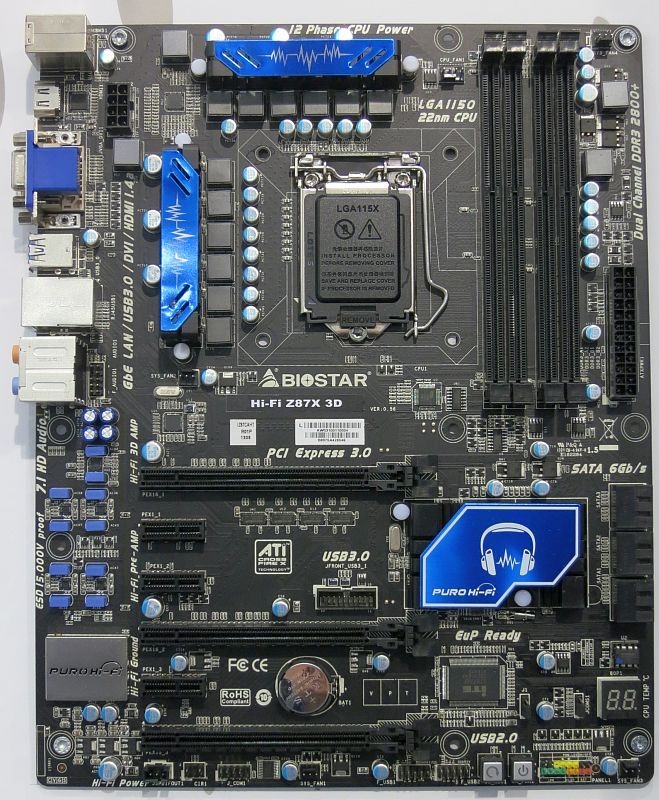
We can see Biostar are slowly upping the number of phases for the CPU (it states on the top of the board 12), and the Puro Hi-Fi takes up a good portion of the left hand side of the board. PCIe allocation looks like an x8/x4/x4 (or x8/x8 + x4), and we get proper power/reset buttons this time around. It is worth noting the very strange location of the USB 3.0 connector – right in the middle of the motherboard. This means a cable stretched across the board, and no luck if you decide to use a triple slot GPU or large PCIe x1 card.
EVGA Z87
With most of the recent releases, EVGA has not been a big player on release day, typically only releasing one or two products with up to three or four motherboards per chipset in total - for example on Z77 we had the FTW and the Stinger. I was lucky enough to catch one of Jacob Freeman’s tweets today showing off their Z87 motherboard:
It looks like we have a new BIOS, that the EVGA board is, as always, looking substantial in terms of heatsinks and PCIe. EVGA employ K¦ngp¦n, one of the world’s top overclockers, who constantly uses EVGA boards to break overclocking world records when he can. Of course I would like to see what EVGA have up their sleeve for this generation.


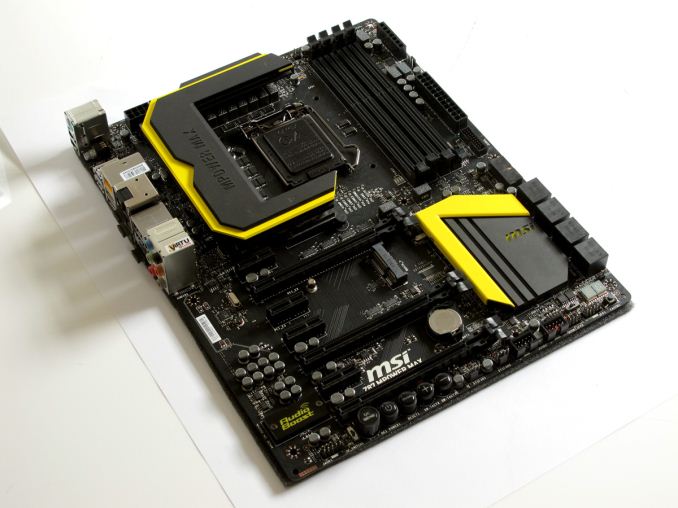
_575px.jpg)







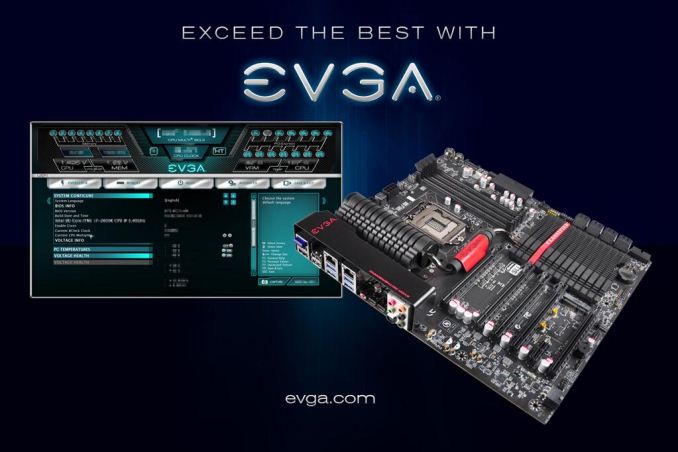








70 Comments
View All Comments
MartinT - Thursday, May 23, 2013 - link
It's strange to think of chosing your last ever motherboard, but this generation has that kind of feeling to me.araczynski - Thursday, May 23, 2013 - link
i look forward to finding a side by side complete line spec comparison some day. always hated trying to make a decision on a mobo since they each started spewing out a dozen parts to do the same thing. probably won't hurt to just wait and let the early adopters deal with the bugs either.Creig - Thursday, May 23, 2013 - link
No mention of the the Gigabyte Z87X-UD3H?http://www.pcauthority.com.au/Gallery/342169,exclu...
n0x1ous - Thursday, May 23, 2013 - link
Love this article. Great job giving us an overview and images of the ranges. Gigabyte gets the nod from me as usual for aesthetics and a much better looking UEFI bios than the Z77 range.Kougar - Thursday, May 23, 2013 - link
The VRM & mosfets was intriguing to read about. If GB is using IR3550 mosfets in the UD5 and ASUS isn't even matching them in its Workstation class motherboard, then I naturally wonder what other PWM & related power delivery choices they differ on. Does GB use them for the memory, chipset, and anything else?
Based on google each single IR chip runs $3 in 10K unit quantities.... no wonder ASUS is using alternatives? Good primer on the IR3550's at http://www.youtube.com/watch?v=6Fl1iFtOLKU
Rovek - Friday, May 24, 2013 - link
i`m interested if i can overclock an Intel Core i5-4570 to 4GHz on a 100 EURO MBAdirzv - Sunday, May 26, 2013 - link
Is there any motherboard that supports 4 displays out of the box? I'm not into gaming, 3D performance is zero for me. I just need 4 monitors for multiple financial application. I'll probably buy the 4770k and i like my system as silent as possible. I would really like to get rid of the video card, which is the loudest component in my systememperius - Thursday, June 6, 2013 - link
Hehe I know what your up to, I also need the same setup. I doubt a mobo has 4 display out without any mods to it that may reduce performance significantly and look tacky. But yet again it's either a single graphics card with 4 displays out or perhaps, in the near close future, Thunderbolt and later daisy chain 4 displays......Bad213Boy - Thursday, May 30, 2013 - link
How could you not mention MSI’s Ceasefire which is infact a swtich that can disable an unused expansion slot so that it can transfer the extra lanes to an occupied slot for full use. This is huge IMO. I haven't heard of any other motherboard doing this.Dil2020 - Sunday, August 4, 2013 - link
Since someone at anandtech has gone to all this trouble of providing details of various motherboards, could someone please answer a simple question:Does the ASUS Z87-WS supports ECC memory?
It does support Xeon processors.